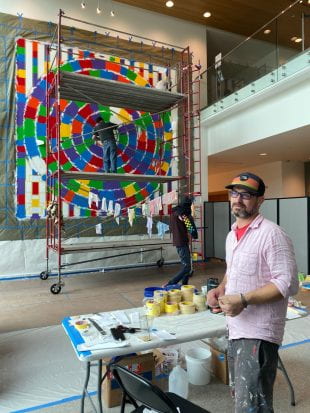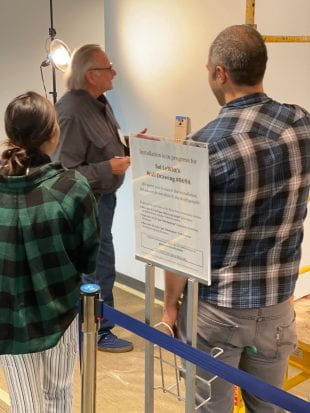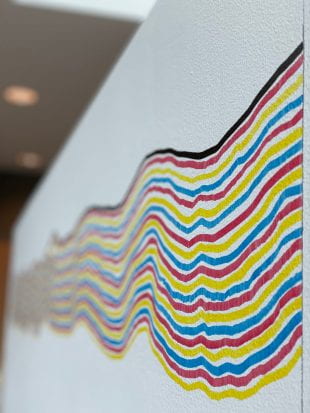Continuing Studies continues the legacy of an artist who changed the notion of public art
The sunny Dean’s Commons inside Rice’s Susanne M. Glasscock School of Continuing Studies was abuzz with activity Nov. 4 in preparation for installations of two Sol LeWitt wall drawings, “Wall Drawing #1115,” recently gifted to Rice Public Art by H. Russell Pitman ‘58, and “Wall Drawing #869A,” a long-term loan from the Estate of Sol LeWitt.

A team of professional draftspeople led by Gabriel Hurier installed the massive “Wall Drawing #1115: Circle within a square, each with broken bands of color” (2014).
Snacks and coffee were scattered for the volunteers helping install LeWitt’s “Wall Drawing #869A,” while scaffolding and cans of paint in bright colors took up the other end of the airy space, where a team of professional draftspeople led by Gabriel Hurier worked on the massive “Wall Drawing #1115: Circle within a square, each with broken bands of color” (2014).
Over the din, the sounds of Pink Floyd drifted throughout the commons. Fitting, as it turns out.
“Music was a constant in Sol’s life,” said John Hogan, the installations director for the LeWitt Estate and installations director and archivist for Sol LeWitt Wall Drawings at Yale University Art Gallery. “There was never silence in his studio; there was always music.”
It’s been over 40 years since Hogan first met and began assisting LeWitt, the renowned American artist who pioneered conceptual art prior to his 2007 death. In that time, Hogan estimates he’s executed close to 400 of LeWitt’s wall drawings and supervised another 400. Each time, he learns something new.
“There’s always a new set of hands, a new place, a new set of things that go right or wrong, a new set of personalities,” Hogan said. His explanations and instructions also have to accommodate those variables, especially the skill sets of those hands helping to install the latest wall drawing — each one a temporally untethered work classified as “contemporary” despite LeWitt’s death more than 12 years ago, by virtue of the way LeWitt’s drawings are executed.
Think of it like a musical score. LeWitt often did.
The artist, as composer, creates a set of instructions for a group to follow. A conductor, such as Hogan, someone trained in interpreting that score, directs the execution of the work. LeWitt did not “perform” his own wall drawings; his art was in the concept, in the idea. He relied on the “democratic hand” of a group to bring his art to life on the wall. He still relies on it, in fact, as LeWitt’s wall drawings continue to be installed across the world.

John Hogan, the installations director for the LeWitt Estate, instructs Martel College senior Jenny Wang and VADA professor Josh Bernstein on the installation of “Wall Drawing #869A.”
“He felt very strongly that (his work) needed to be democratic, that it should only reflect the idea, that it shouldn’t be his hand,” Hogan said. “It should be, you know, this collaboration.”
At Rice, a small group of faculty and students — a mix of Glasscock continuing studies students and Rice undergrads, as well as Rice studio art faculty and Glasscock studio art instructors — were selected to bring “Wall Drawing #869A” to life.
It’s a “copied line” drawing, meaning Hogan draws the “base” line — setting the tempo as conductor, if you will — and the group recreates that line over and over again, following LeWitt’s specific instructions with regard to color and pattern, until the frame of the wall drawing is filled. Not every hand-drawn line will be perfect, but that’s OK.
Or, as Hogan put it: Two musicians each play the same Bach sonata. “They’re both Bach pieces, and you might like one better than the other,” Hogan said. “But ultimately, they’re still both Bach.”
This piece, “Wall Drawing #869A,” has never before been installed anywhere in the world, so Hogan spent plenty of time rehearsing with the group Monday morning. A practice section of wall had been wheeled in, along with LeWitt’s preferred markers for the piece. Visual and Dramatic Arts professors Natasha Bowdoin and Josh Bernstein and Glasscock studio art instructors Ellen Orseck and Laura Spector were among those who stood copying Hogan’s practice lines.
“You need to not hold it like you’re writing with a pen or a pencil,” Hogan told the group, gripping a marker himself. “You have to angle it a little bit more, maybe 20 degrees off of 90, so that you’re getting the full width of the marker.”
By lunchtime, Hogan felt the group was ready.
They left the team of professional LeWitt performers downstairs to finish installing the monumental “Wall Drawing #1115” and headed to a more intimate area on the second floor, where “Wall Drawing #869A” will greet Glasscock students and other guests on the main landing.
It’s an ideal location for a LeWitt piece executed by some of those very same students, in a building devoted to continuing education and continuing the transmission of knowledge across generations.
“He felt very strongly that art should be out in the public,” Hogan said. “And he created artworks that are not, per se, precious — that can be repeated and can involve the public, be they trained or untrained.”
When he’s not busy overseeing installations, Hogan spends his time contemplating and researching the best means of communicating LeWitt’s vision to future generations who will not have known or worked with the artist. This, too, is a temporally untethered task that requires as much faith as LeWitt put in the democratic hand.
“There’s enough examples of where things that were common knowledge simply fall off the grid,” Hogan said. “Do we trust inherently in the system that Sol created?”
For now, the answer is yes.
“Most artists create things in their studios or workspace and it’s fixed in time,” Hogan said. “They don’t want it to ever change. They want it to always be that way.
“But Sol said, ‘This is the idea. It’s going to go on a wall that might not even be built. It’s going to happen in the future when I’m not even alive.’ He trusted his ideas sufficiently — and the notion that someone would understand his thoughts, that the work could be executed, go forward in time and always be contemporary.”
Additional community activities are planned around the installation of Sol LeWitt’s wall drawings, including “The Big Draw” Nov. 12, the “Solebration: Free Community Opening Reception” Nov. 18 and “Symposium: Sol LeWitt Today” Dec. 7. More information about these events and the Sol LeWitt Project can be found at https://glasscock-info.rice.edu/lewitt.


